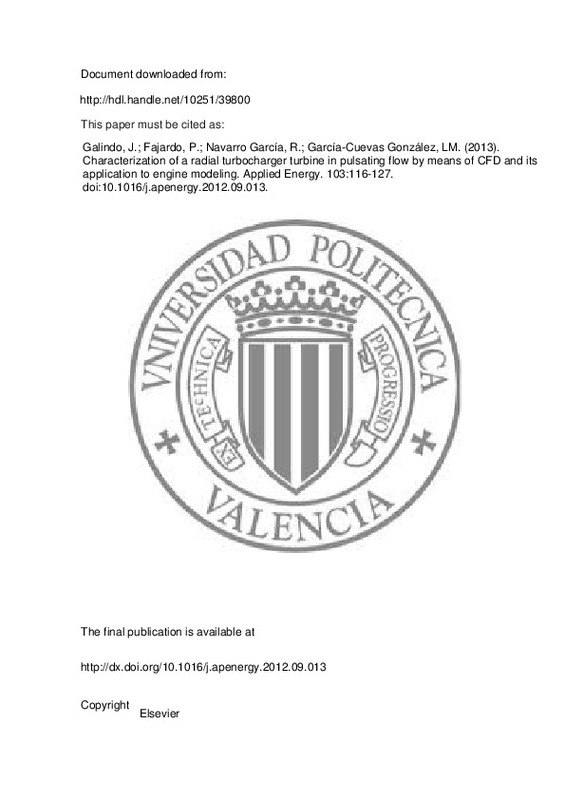JavaScript is disabled for your browser. Some features of this site may not work without it.
Buscar en RiuNet
Listar
Mi cuenta
Estadísticas
Ayuda RiuNet
Admin. UPV
Characterization of a radial turbocharger turbine in pulsating flow by means of CFD and its application to engine modeling
Mostrar el registro sencillo del ítem
Ficheros en el ítem
| dc.contributor.author | Galindo, José
|
es_ES |
| dc.contributor.author | Fajardo, Pablo
|
es_ES |
| dc.contributor.author | Navarro García, Roberto
|
es_ES |
| dc.contributor.author | García-Cuevas González, Luis Miguel
|
es_ES |
| dc.date.accessioned | 2014-09-22T07:26:23Z | |
| dc.date.available | 2014-09-22T07:26:23Z | |
| dc.date.issued | 2013-03 | |
| dc.identifier.issn | 0306-2619 | |
| dc.identifier.uri | http://hdl.handle.net/10251/39800 | |
| dc.description.abstract | This paper presents a numerical study analyzing the effect of pulsating flow in a variable geometry radial inflow turbine. The turbine behavior is analyzed under isentropic pulses, which are similar to those created by a rotating disk in a turbocharger test rig. Three different pulse frequencies (50, 90 and 130 Hz) and two pulse amplitudes (100 and 180 kPa) were considered. Turbine flow was studied throughout the pressure pulsation cycles in a wide range of off-design operating conditions, from low pressure ratio flow detachment to high pressure ratio choked flow. An overall analysis of the phasing of instantaneous mass flow and pressure ratio was first performed and the results show the non-quasi-steady behavior of the turbine as a whole as described in the literature. However, the analysis of the flow in the different turbine components independently gives a different picture. As the turbine volute has greater length and volume than the other components, it is the main source of non-quasi-steadiness of the turbine. The stator nozzles cause fewer accumulation effects than the volute, but present a small degree of hysteretic behavior due to flow separation and reattachment cycle around the vanes. Finally, the flow in the moving rotor behaves as quasi-steady, as far as flow capacity is concerned, although the momentum transfer between exhaust gas and blades (and thus work production and thermal efficiency) is affected by a hysteretic cycle against pressure ratio, but not if blade speed ratio is considered instead. A simple model to simulate the turbine stator and rotor is proposed, based on the results obtained from the CFD computations. | es_ES |
| dc.description.sponsorship | The authors are indebted to the Spanish Ministerio de Economia y Competitividad through Project TRA 2010-16205. The proof-reading of the paper was funded by the Universitat Politecnica de Valencia, Spain. | en_EN |
| dc.language | Inglés | es_ES |
| dc.publisher | Elsevier | es_ES |
| dc.relation.ispartof | Applied Energy | es_ES |
| dc.rights | Reserva de todos los derechos | es_ES |
| dc.subject | CFD Simulation | es_ES |
| dc.subject | Pulsating flow | es_ES |
| dc.subject | Radial turbine | es_ES |
| dc.subject | Turbocharger | es_ES |
| dc.subject | Turbine modeling | es_ES |
| dc.subject | Quasi-steady assumption | es_ES |
| dc.subject.classification | INGENIERIA AEROESPACIAL | es_ES |
| dc.subject.classification | MAQUINAS Y MOTORES TERMICOS | es_ES |
| dc.title | Characterization of a radial turbocharger turbine in pulsating flow by means of CFD and its application to engine modeling | es_ES |
| dc.type | Artículo | es_ES |
| dc.identifier.doi | 10.1016/j.apenergy.2012.09.013 | |
| dc.relation.projectID | info:eu-repo/grantAgreement/MICINN//TRA2010-16205/ES/SUPERACION DE LIMITES TERMOFLUIDODINAMICOS EN MICRO-MOTORES DIESEL PARA VEHICULOS HIBRIDOS ENCHUFABLES/ | es_ES |
| dc.rights.accessRights | Abierto | es_ES |
| dc.contributor.affiliation | Universitat Politècnica de València. Departamento de Máquinas y Motores Térmicos - Departament de Màquines i Motors Tèrmics | es_ES |
| dc.contributor.affiliation | Universitat Politècnica de València. Instituto Universitario CMT-Motores Térmicos - Institut Universitari CMT-Motors Tèrmics | es_ES |
| dc.description.bibliographicCitation | Galindo, J.; Fajardo, P.; Navarro García, R.; García-Cuevas González, LM. (2013). Characterization of a radial turbocharger turbine in pulsating flow by means of CFD and its application to engine modeling. Applied Energy. 103:116-127. https://doi.org/10.1016/j.apenergy.2012.09.013 | es_ES |
| dc.description.accrualMethod | S | es_ES |
| dc.relation.publisherversion | http://dx.doi.org/10.1016/j.apenergy.2012.09.013 | es_ES |
| dc.description.upvformatpinicio | 116 | es_ES |
| dc.description.upvformatpfin | 127 | es_ES |
| dc.type.version | info:eu-repo/semantics/publishedVersion | es_ES |
| dc.description.volume | 103 | es_ES |
| dc.relation.senia | 233707 | |
| dc.contributor.funder | Ministerio de Ciencia e Innovación | es_ES |
| dc.contributor.funder | Universitat Politècnica de València | es_ES |







![[Cerrado]](/themes/UPV/images/candado.png)

